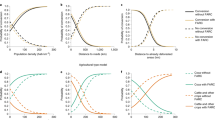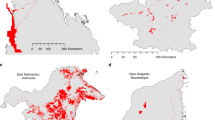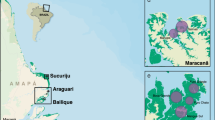Abstract
Land degradation in the Sahel threatens livelihoods and food security. The Great Green Wall programme is a colossal initiative to restore 100 million hectares of degraded ecosystems across 11 countries in the region, which started in 2007 to also promote sustainable development and climate change mitigation. We evaluated the economic costs and benefits of future land restoration projects under this programme. We applied different scenarios that account for both market-priced and non-market benefits from restored ecosystems and consider the heterogeneity of local decision-making contexts in terms of investment planning horizons, discount rates, and the time needed for the restored ecosystems to start yielding their benefits in full. The results show that every US dollar invested into land restoration yields on average US$1.2 under the base scenario, ranging from US$1.1 to US$4.4 across the scenarios. At most, ten years are needed for land restoration activities to break even from the social perspective, accounting for both market-priced and non-market ecosystem benefits. To fund all proposed land restoration activities, an investment of US$44 billion is needed under the base scenario (US$18–70 billion across scenarios). Violent conflicts in the Sahel are estimated to reduce the accessibility to these degraded ecosystems from 27.9 million hectares to 14.1 million hectares. The study highlights activities and locations where land restoration is both economically attractive and ecologically sustainable, even after accounting for lower survival rates of planted trees and grasses, persistence of land degradation drivers and the growing number of violent conflicts hindering land restoration in the Sahel. This information can help improve the targeting of future land restoration activities in the region.
This is a preview of subscription content, access via your institution
Access options
Access Nature and 54 other Nature Portfolio journals
Get Nature+, our best-value online-access subscription
$29.99 / 30 days
cancel any time
Subscribe to this journal
Receive 12 digital issues and online access to articles
$119.00 per year
only $9.92 per issue
Buy this article
- Purchase on Springer Link
- Instant access to full article PDF
Prices may be subject to local taxes which are calculated during checkout



Similar content being viewed by others
Data availability
The data generated by the current study are available in the paper and Supplementary Materials. The citations to the external data sources used by the study are given in the references and Supplementary Materials. All correspondence and requests for materials should be addressed to the corresponding author.
Code availability
The codes used in the analysis are available at Open Science framework (https://osf.io/7kaer/).
References
Moussa, B. et al. in Economics of Land Degradation and Improvement—A Global Assessment for Sustainable Development (eds Nkonya, E. et al.) 499–539 (Springer, 2016); https://doi.org/10.1007/978-3-319-19168-3_17
Sow, S., Nkonya, E., Meyer, S. & Kato, E. in Economics of Land Degradation and Improvement—A Global Assessment for Sustainable Development (eds Nkonya, E. et al.) 577–608 (Springer, 2016); https://doi.org/10.1007/978-3-319-19168-3_19
Gebreselassie, S., Kirui, O. K. & Mirzabaev, A. in Economics of Land Degradation and Improvement—A Global Assessment for Sustainable Development (eds Nkonya, E. et al.) 401–430 (Springer, 2016); https://doi.org/10.1007/978-3-319-19168-3_14
Nkonya, E., Johnson, T., Kwon, H. Y. & Kato, E. in Economics of Land Degradation and Improvement—A Global Assessment for Sustainable Development (eds Nkonya, E. et al.) 215–259 (Springer, 2016); https://doi.org/10.1007/978-3-319-19168-3_9
Ogunlela, V. & Ogungbile, A. Alleviating rural poverty in Nigeria: a challenge for the national agricultural research system. J. Food Agric. Environ. 6, 493–499 (2006).
Barbier, E. B. & Hochard, J. P. Land degradation and poverty. Nat. Sustain. 1, 623–631 (2018).
Mbow, C. The Great Green Wall in the Sahel (Oxford Univ. Press, 2017).
Moussa, B. et al. in Economics of Land Degradation and Improvement—A Global Assessment for Sustainable Development (eds Nkonya, E. et al.) 499–539 (Springer, 2016); https://doi.org/10.1007/978-3-319-19168-3_17
Benjaminsen, T. A. in The End of Desertification? Disputing Environmental Change in the Drylands (eds Behnke, R. & Mortimore, M.) 99–116 (Springer, 2016); https://doi.org/10.1007/978-3-642-16014-1_4
Get Africa’s Great Green Wall back on track. Nature 587, 8 (2020).
Sacande, M. & Berrahmouni, N. Community participation and ecological criteria for selecting species and restoring natural capital with native species in the Sahel. Restor. Ecol. 24, 479–488 (2016).
Harmonized Regional Strategy for the Implementation of the Great Green Wall for the Sahara and the Sahel Initiative (AUC/PAGGW, 2012).
Goffner, D., Sinare, H. & Gordon, L. J. The Great Green Wall for the Sahara and the Sahel initiative as an opportunity to enhance resilience in Sahelian landscapes and livelihoods. Reg. Environ. Change 19, 1417–1428 (2019).
The Great Green Wall Implementation Status and Way Ahead to 2030 (UNCCD, 2020).
van der Ploeg, S., Wang, Y., Gebre Weldmichael, T. & de Groot, R. S. The TEEB Valuation Database – A Searchable Database of 1310 Estimates of Monetary Values of Ecosystem Services (Foundation for Sustainable Development, 2010).[endif]
De Groot, R.S., Kumar, P., van der Ploeg, S. & Sukhdev, P. in The Economics of Ecosystems and Biodiversity: Ecological and Economic Foundations (ed. Kumar, P.) Appendix 3 (Earthscan, 2010).
Nkonya, E. et al. in Economics of Land Degradation and Improvement—A Global Assessment for Sustainable Development (eds Nkonya, E. et al.) 117–165 (Springer, 2016); https://doi.org/10.1007/978-3-319-19168-3_6
Costanza, R., Groot, Rde & Sutton, P. Changes in the global value of ecosystem services. Glob. Environ. Change 26, 152–158 (2014).
Millennium Ecosystem Assessment Ecosystems and Human Well-being: Synthesis (Island Press, 2005).
Countries Requiring External Assistance for Food (GIEWS, 2021).
The Interim NDC Registry (UNFCCC, 2021).
ClimateChange Profile West African Sahel (Ministry of Foreign Affairs of the Netherlands, 2018).
Pannell, D. J., Llewellyn, R. S. & Corbeels, M. The farm-level economics of conservation agriculture for resource-poor farmers. Agric. Ecosyst. Environ. 187, 52–64 (2014).
Sacande, M., Martucci, A. & Vollrath, A. Monitoring large-scale restoration interventions from land preparation to biomass growth in the Sahel. Remote Sensing 13 (2021).
Feldt, T., Karg, H., Kadaouré, I., Bessert, L. & Schlecht, E. Growing struggle over rising demand: How land use change and complex farmer–grazier conflicts impact grazing management in the Western Highlands of Cameroon. Land Use Policy 95, 104579 (2020).
Dimelu, M. U., Salifu, E. D. & Igbokwe, E. M. Resource use conflict in agrarian communities, management and challenges: a case of farmer–herdsmen conflict in Kogi State, Nigeria. J. Rural Stud. 46, 147–154 (2016).
Turner, M. D., Ayantunde, A. A., Patterson, K. P. & Patterson, E. D. Livelihood transitions and the changing nature of farmer–herder conflict in Sahelian West Africa. J. Dev. Stud. 47, 183–206 (2011).
Brottem, L. V. Pastoral resource conflict in the context of Sudano–Sahelian security crises: a critical review of research. Afr. Secur. 13, 380–402 (2020).
Brottem, L. V. Environmental change and farmer–herder conflict in Agro-Pastoral West Africa. Hum. Ecol. 44, 547–563 (2016).
Hertel, T. W., Burke, M. B. & Lobell, D. B. The poverty implications of climate-induced crop yield changes by 2030. Glob. Environ. Change 20, 577–585 (2010).
Mbow, C. et al. in Special Report on Climate Change and Land (eds Shukla, P. R. et al.) Ch. 5 (IPCC, 2019).
Sundberg, R. & Melander, E. Introducing the UCDP Georeferenced Event Dataset. J. Peace Res. 50, 523–532 (2013).
Pettersson, T. & Öberg, M. Organized violence, 1989–2019. J. Peace Res. 57, 597–613 (2020).
van Vliet, N., Reenberg, A. & Rasmussen, L. V. Scientific documentation of crop land changes in the Sahel: a half empty box of knowledge to support policy? J. Arid Environ. 95, 1–13 (2013).
Prince, S. et al. in The Assessment Report on Land Degradation and Restoration (eds Montanarella, L. et al.) 221–338 (IPBES, 2018).
Leroux, L., Bégué, A., Lo Seen, D., Jolivot, A. & Kayitakire, F. Driving forces of recent vegetation changes in the Sahel: lessons learned from regional and local level analyses. Remote Sens. Environ. 191, 38–54 (2017).
Burrell, A. L., Evans, J. P. & De Kauwe, M. G. Anthropogenic climate change has driven over 5 million km2 of drylands towards desertification. Nat. Commun. 11, 3853 (2020).
Paris Agreement (United Nations, 2015); https://unfccc.int/sites/default/files/english_paris_agreement.pdf, accessed on 20.10.2021
Verhoeven, H. Climate change, conflict and development in Sudan: global neo-Malthusian narratives and local power struggles. Dev. Change 42, 679–707 (2011).
Behrend, H. in Land Restoration: Reclaiming Landscapes for a Sustainable Future (eds Chabay, I. et al.) 13–26 (Elsevier, 2016); https://doi.org/10.1016/B978-0-12-801231-4.00004-5
Iiyama, M. et al. The potential of agroforestry in the provision of sustainable woodfuel in sub-Saharan Africa. Curr. Opin. Environ. Sustain. 6, 138–147 (2014).
Mirzabaev, A. et al. Bioenergy, food security and poverty reduction: trade-offs and synergies along the water–energy–food security nexus. Water Int. 40 (2015).
Legesse, B. A., Jefferson-Moore, K. & Thomas, T. Impacts of land tenure and property rights on reforestation intervention in Ethiopia. Land Use Policy 70, 494–499 (2018).
Shittu, A. M., Kehinde, M. O., Ogunnaike, M. G. & Oyawole, F. P. Effects of land tenure and property rights on farm households’ willingness to accept incentives to invest in measures to combat land degradation in Nigeria. Agric. Resour. Econ. Rev. 47, 336–356 (2018).
Friedl, M. & Sulla-Menashe, D. MCD12Q1 MODIS/Terra+Aqua Land Cover Type Yearly L3 Global 500m SIN Grid Version 006 (NASA EOSDIS Land Processes DAAC, 2019).
Olsson, L. et al. in Special Report on Climate Change and Land (eds Shukla, P. R. et al.) Ch. 4 (IPCC, 2019).
Sustainable Land Management Sourcebook (World Bank, 2008).
Global Guidelines for the Restoration of Degraded Forests and Landscapes in Drylands. Building Resilience and Benefitting Livelihoods Forestry Paper 175 (FAO, 2015).
Acknowledgements
The collaboration and support of the Pan-African and National agencies of the Great Green Wall are acknowledged. We also thank J. von Braun for comments and suggestions on the earlier versions of the paper. This study was conducted under Action Against Desertification, an initiative of the Organisation of African, Caribbean and Pacific States (OACPS), implemented by the United Nations’ Food and Agriculture Organization and funded by the European Union (GCP/INT/157/EC).
Author information
Authors and Affiliations
Contributions
A.Mirzabaev conceived and designed the analysis, planned and supervised the work, collected the data, implemented the analysis, interpreted the data and wrote the manuscript. M.S. planned and supervised the work and contributed to data interpretation and writing of the manuscript. F.M. collected the data, contributed to data analysis and produced the maps. A.S. collected the data and contributed to data interpretation and preparation of Supplementary Materials. A.Martucci contributed to data analysis and produced the maps.
Corresponding author
Ethics declarations
Competing interests
The authors declare no competing interests.
Additional information
Peer review information Nature Sustainability thanks Jacob Hochard and the other, anonymous, reviewer(s) for their contribution to the peer review of this work.
Publisher’s note Springer Nature remains neutral with regard to jurisdictional claims in published maps and institutional affiliations.
Extended data
Extended Data Fig. 1 Median values of ecosystem services in the Sahel region (USD per hectare).
Source: estimated by the authors based on the references indicated in Supplementary Material 8.
Extended Data Fig. 2 Assumptions for land restoration activities.
Note: The assumptions imply that restored forests, woodlands, shrublands and wetlands do not start yielding their all ecosystem benefits immediately but reach their full potential gradually.
Extended Data Fig. 3 Country-specific benefit cost ratios of restoring degraded biomes across the scenarios.
Note: The ranges signify minimum and maximum returns (in USD) for each USD invested for restoration across the scenarios.
Extended Data Fig. 4 Regional benefit-cost ratios of restoring degraded biomes under each scenario.
Note: S-Scenario. The numbers signify the average returns (in USD) at the regional level for each USD invested for restoring each biome.
Extended Data Fig. 5 Locations suitable for land restoration after accounting for conflicts.
Note: The underlying analysis assumes that land restoration is not possible in areas which are within 50 km of violent conflict spots. The map shows the findings for the base scenario 1. Source: the authors.
Extended Data Fig. 6 Locations of violent conflicts across the Sahel region.
Note: The map shows the locations of incidences of violent conflicts and one-sided violence since 2015 exceeding 25 fatalities a year. Source: produced by the authors based on Uppsala Conflict Data Program (UCDP) database.
Supplementary information
Supplementary Information
Supplementary Materials 1–8.
Rights and permissions
About this article
Cite this article
Mirzabaev, A., Sacande, M., Motlagh, F. et al. Economic efficiency and targeting of the African Great Green Wall. Nat Sustain 5, 17–25 (2022). https://doi.org/10.1038/s41893-021-00801-8
Received:
Accepted:
Published:
Issue Date:
DOI: https://doi.org/10.1038/s41893-021-00801-8
This article is cited by
-
Afforesting arid land with renewable electricity and desalination to mitigate climate change
Nature Sustainability (2023)
-
Nation-wide mapping of tree-level aboveground carbon stocks in Rwanda
Nature Climate Change (2023)
-
Valuing ecological restoration benefits cannot fully support landscape sustainability: a case study in Inner Mongolia, China
Landscape Ecology (2023)
-
Sub-continental-scale carbon stocks of individual trees in African drylands
Nature (2023)
-
Investing wisely in land restoration
Nature Sustainability (2021)



